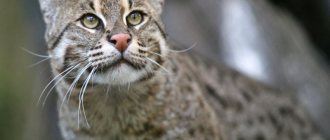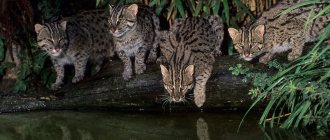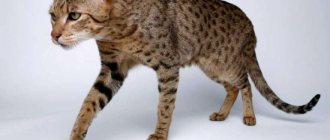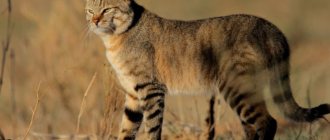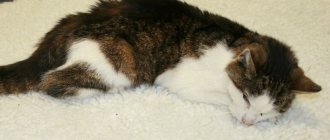Captivity
Charismatic appearance and funny habits attract more and more attention to the civet cat. Many exotic lovers began to express a desire to keep the animal as a pet after the website of the famous fishing cat named John Davis, who lived with his owners for three years in the most ordinary apartment in the city of Krasnoyarsk, was widely promoted on the Internet.
This is the most famous fishing cat from Krasnoyarsk - John Davis
Taming
A wild animal will never be able to become a “plasticine” pet, and the Krasnoyarsk story is a clear confirmation of this. But if it so happens that you want to take a risk and repeat the attempt to tame an Asian cat, do not get a male, there is practically no chance of reaching an amicable agreement with him. Females of this species are much more docile.
Taming begins at an early age, no later than three months, until the kitten is able to naturally perceive a person as a member of its family. Contact must be established gradually, and in no case should you frighten the animal or put pressure on it. At the first stage, you should ensure that the cub learns to take pieces of food from your hands without any problems.
Taming and feeding a wild kitten will be simplified by your domestic cat
Aviary keeping is not suitable - if you want to get a truly tame pet, you will have to pay maximum attention to it and spend a lot of time communicating together. The fishing cat is very jealous and remembers insults well - this should also be taken into account. He may well find a common language with other cats and even with the dogs with whom he grew up in the house, but on occasion he will not deny himself the pleasure of hunting someone whom he considers weaker than himself.
The character of the “tame cat” is very complex
These animals are extremely intelligent and quick-witted, they very quickly perceive the rules of behavior in captivity and the hierarchy of their new pack. Usually, a fishing cat chooses only one owner, whom he considers the main one, and agrees to obey him. This stubborn cunning man can significantly ignore the demands of other family members
But he can show serious jealousy, protecting the attention of his beloved owner from other household members - but such moments are sometimes fraught with serious danger
Content nuances
The main problems when keeping a viverrid cat in captivity can arise when the animal enters puberty. Zoologists recommend castrating your pet in a timely manner; this will help stop manifestations of aggression and make the cat more manageable. But such measures will also not provide guarantees of unclouded coexistence of wild animals on the same territory as humans.
The fishing cat adapts well to the zoo environment
A cramped cage is disastrous for an inquisitive, active and mobile wild cat - it needs a lot of space and impressions: sufficient territory for walking and several different shelters. If there are good living conditions and adequate nutrition, a pair of fishing cats will quite possibly be concerned about procreation and bring forth charming offspring.
These animals have a very strong immune system and good resistance to infectious diseases. However, before changing teeth, it is necessary to vaccinate the kitten twice with a complex vaccine and then repeat the vaccination annually. There are cases where Asian cats lived in well-fed and prosperous conditions of captivity for up to twenty years.
The charming appearance of the civet cat is deceptive, and it is better to observe its behavior and habits from a distance. Do not experiment with keeping wild animals in your home, do not try to turn them into harmless fluffies. Nature cannot be fooled, and the habits of a wayward savage can take over, creating a serious danger for all the inhabitants of your home.
Origin of the species and description
Photo: Fishing cat
The fishing cat has many names:
- fish cat;
- speckled cat;
- civet cat;
- Asian fish cat.
The cat is called speckled because of its fur, which is covered with dark spots (speckles). He acquired the adjective “viverrid” to his name, because outwardly very similar to the predator civet (civet), living in the subtropics. This predator of the cat family leads a rather secretive and solitary life, living in places where humans often cannot get.
Little is known about the history of the origin of this feline species. Only one thing is clear: the predator avoids communication with people and has a wild and unbridled disposition. The very name of this animal speaks not only of its taste preferences, but also of its favorite habitats, where there should always be water nearby.
Video: Fishing cat
Zoological scientists distinguish two varieties of these interesting mustachioed predators. Both of them have almost no differences in appearance, the only difference is their dimensions. The cats that settled in the south, southeast of Asia and on the island of Sumatra inclusive are much larger than their fellow tribesmen living in Bali and Java. The population of these unusual cats is very small, the animals keep to themselves, so until now very little is known about their wild way of life.
Many characteristic features and habits have been studied only on specimens living in captivity. This genus of oriental cats is special, differing in many respects from ordinary felines. Let's try to understand individual nuances in more detail and find out as much as possible about the life activity of this mysterious cat.
Range of miniature predators
African wild cats live in the desert regions of South Africa. The animals have chosen a number of countries: Botswana, Angola, Namibia, Zimbabwe and South Africa. Scientists distinguish two varieties of black-footed cats. The more numerous of them are light in color and live in Namibia. The second group is much smaller in number and its representatives live in Botswana.
In a number of countries, rare wild cats are protected and hunting them is prohibited. Thus, Botswana and South Africa are concerned about preserving the population. In these countries, work is underway to combat poachers. In addition, animals often die from dog attacks and under the wheels of cars. Human activity also has a negative impact on the population size.
Description of the fishing cat
Like most wild predators, the appearance, habits and character of a fishing cat are entirely dependent on natural conditions. After all, hunting for prey is a process on which the life of a cat and its offspring depends, so it is necessary to have a coloring that is consistent with the general nature and a strong body.
The animal swims and dives well in search of prey
External data
An adult civet fishing cat weighs up to 15 kg. The body can be from 96 to 120 cm in length, and the height at the withers can be from 38 to 40 cm. Moreover, cats are twice lighter and smaller than males.
The animals have a strong physique, characteristic of all representatives of the cat family. At the same time, the following external signs are considered to be the distinctive features of a fishing cat:
- short skull shape;
- practically absent bridge of the nose;
- round and very powerful jaw;
- ears are small and round in shape;
- short thick neck;
- short legs;
- shortened tail length;
- Webbing on the front paws between the toes.
The color allows the cat to remain invisible against the backdrop of wild nature.
The color of the civet fishing cat is standard: the skin is grayish-brown with black spots. The fur is thick, short, and has waterproof properties. The skin has a matte finish, which allows the angler to blend into the environment.
On land, the cat moves somewhat awkwardly, trying to cling to the ground. The tail is used for balancing while walking and swimming. It has the same thickness throughout its entire length, and in all cats it is necessarily striped.
Character
The civet cat has the typical character of a predator. Typically, the female occupies a territory of up to 8 km². This space is enough for her not only to hunt, but also to feel safe for her cubs. An adult male fishing cat defends his rights to a much larger area - about 22 km².
Among the natives, fishermen have long been known as bullies and brawlers, although they avoid meeting people. Cats conflict not only with other animals, but also with each other if a stranger has violated the boundaries of someone’s territory. This is perhaps the most important quality in their character.
Since zoological observations of fishing cats are very rare, and they are practically not kept in captivity, little is also known about the nature of the animals. The fisherman is very handsome and unusual in appearance, but his attractive appearance is in no way associated with the temperament of a serious killer cat.
The image of a “cute cat” does not fit in with the character of a cunning and strong predator
Habitat
Viverrid fishing cats can be found in the tropics or subtropics. Therefore, they are accustomed to hot climates and have never seen snow. The optimal temperature for these cats is 25–30 degrees Celsius. Animals live in dense forests near swamps, rivers and lakes, which greatly alleviates the effects of heat. Geographically, the range of fishermen is the countries of Southeast Asia:
- India;
- Indochina;
- Ceylon;
- Sumatra;
- Java.
At the same time, cats from the island of Java are significantly inferior in size to their relatives from the continent.
Best articles: Antigadin for cats: a way to train your pet to use the litter box
The dense, humid forests of Asia are the favorite habitat of fishing cats.
Nutrition
The civet fishing cat knows how to swim well - the waterproof undercoat and membranes on the front legs help him in this. Thanks to this skill, they build their own line of hunting: they wait for prey on the shore, and then rush at the prey in one jump. Cats can also walk in shallow water in search of small animals: frogs, crabs or snails.
Hunting for fish requires more skill, so the cat can not only swim, but also dive to depths. Fish constitutes the main diet. Cats are very cunning and lure fish from the depths to shallow water with light strikes of their paws on the water. The fish, feeling the vibrations of the water, swims towards the blow in the hope that it is an insect that is drowning, but ends up in the tenacious paws of the cat.
In “hungry” years, the fisherman does not even disdain carrion, catching snakes and insects. In extremely rare cases, a fishing cat may attack livestock (for example, catch a lamb or kid).
For its food, the fishing cat uses almost all types of small animals, insects and fish.
Reproduction
Viverrid cats do not have a specific mating season - they can breed all year round. This is explained by their habitat - it is always warm in tropical and subtropical Asian forests.
Puberty occurs in the second or third year of life. Pregnancy lasts approximately 63–70 days, after which the female gives birth to two or three cubs. Growing up takes 9 months, after which the kittens can live independently away from their parents.
It takes 9 months for civet kittens to grow up.
Viverrid fishing cat
This is incredible! There are cats in the world that are not afraid of water. Not only are they not shy at the sight of the lake, but they also frolic in it with pleasure. Moreover, the reservoir for these animals is the main source of food. Who is this?! We present to your attention an Asian predator - the civet cat, or fish cat.
Where does the fishing cat live?
The fishing cat lives in Asian countries
You can meet an unusual lover of water treatments only in Asian countries: India, China, Thailand, Sri Lanka. It also lives on the island of Java.
It prefers to hunt in the humid subtropics of the jungle, closer to open water bodies, and is not averse to walking through the swamp in search of food.
In captivity, the wild fisher is kept in zoos in Europe and, naturally, Asia.
Description of the breed
In appearance, the speckled cat, as it is also called, is something between a Far Eastern cat and a civet. It is relatively small, but quite large relative to its domesticated furry relatives. The average weight of males is 15 kg, females - 10 kg. Inside the small body lies uncontrollable strength and power: according to rumors, in a fight with a leopard, the fish cat always remains the winner.
The head of the animal is of interest: it is round with a massive lower jaw. The shape of the ears and nose is ideal for diving. The front toes are webbed, which is why the cat never retracts its claws.
The hunter’s exclusively terrestrial lifestyle also affected his gait: his body was squat with powerful short legs. Unlike other representatives of the cat fauna, the civet's tail is short and thick, and does not taper downward. He uses it instead of a rudder when swimming.
The camouflage gray-brown-black coat color allows the cat to remain unnoticed in the thickets of the tropical jungle.
Viverrid cat on the hunt
Wild cats feed mainly on river inhabitants: crustaceans, mollusks, frogs, and fish. In search of prey, civets wander through shallow water or wait for prey on the shore. When they discover a hunting object, they dive under the water with the speed of lightning - no one has ever managed to dodge the tenacious and strong paws of a predator.
Far from a body of water, they will not disdain birds and rodents, but catching agile animals is problematic for a cat clumsy on land. Cases have been recorded of hungry predators attacking sheep herds while feasting on newborn lambs.
Habits of a fish cat
Civets hunt river inhabitants
The civet cat has gained fame as a bully and rowdy. He can easily deal with both a pack of dogs and an enemy twice his size. From time to time he wanders into the village, where he is not averse to eating poultry, for which he is punished by angry local residents.
He doesn’t particularly like to climb trees, prefers to swim and walk in shallow water more and more. Leads a twilight lifestyle, resting in a shelter during the day. Each representative is assigned his own territory, entering which by others is fraught with beatings.
Civets and humans
Despite their cantankerous nature, wild predators are easily tamed, finding a common language with their owners. However, keeping a civet cat at home poses a number of difficulties.
- The animal is a freedom-loving animal, it needs space - even in a country house it is cramped and uncomfortable.
- A constant craving for water treatments will become a stumbling block - an ordinary bath is clearly not enough to satisfy wild hunting instincts.
They are fed, as in their natural habitat, fish, and sometimes they are pampered with chicken meat with bones. They don’t forget about vaccination: the vaccinations are the same as for regular pets.
Contact games with a strong animal are fraught with injuries, so it is better to use toys rather than hands for communication. The cats are quite obedient and not particularly mischievous, but do not tolerate shouting or violence.
If you have money, getting a civet cat is not a problem. But it’s worth knowing that the species is listed in the Red Book, and keeping in captivity is punishable by law in many countries of the world.
Who else isn't afraid of water?
In fact, the civet cat is not the only one who loves to swim. For example, Bengal cats are also not averse to frolicking in the bathroom with their owner. The Kurilian Bobtail, Turkish Van and African Soukok can confidently be included in this category of swimming fluffies.
For a striking example of a fishing cat hunting, watch the video:
https://www..com/watch?v=1jYmJk_tIAg
Population and species status
Photo: Animal fishing cat
A rare fishing cat can become a legend if a person does not think about his harmful activities, which affect many animals. The population of this feline species has declined so much that the threat of its extinction is more pressing than ever. Fishing cats are dying out due to unfavorable environmental conditions, thanks to the destruction of swamps and deforestation. Often, animals do not have enough food due to mass hunting and fishing. Hunting activities to exterminate fishing cats because of their fur and fangs also brought negative and depressing results.
Interesting facts about the Fisherman cat
- The fishing cat has a unique jaw structure and very powerful fangs, allowing it to hunt large prey. This is a true "feline pit bull terrier".
- False “eyes” on the back of the ears are also an indicator of the animal’s condition. If they are not visible, it means that the ears are pressed to the head, and the cat is angry and dangerous.
- The size of female Anglers corresponds to the size of an ordinary domestic cat with a more powerful build, but males are at least twice as large.
- When diving, a civet cat is able to press its ears very tightly to its head, protecting them from water.
- The Speckled Cat's nose also has a special structure that allows it to hold its breath and prevent water from entering the respiratory tract.
Character, temperament
The civet cat is mainly nocturnal and always lives near water. It can climb trees, but very rarely does this; it mainly wanders in shallow water in search of prey.
Very smart and cunning, luring the victim, it hits the water with its paw. When there are ripples on the surface of a reservoir, underwater inhabitants think that this is the movement of insects and rise to the top. An adult is capable of swimming long distances, up to several kilometers.
Sexually mature females and males lead a solitary lifestyle, carefully marking their habitat with their own scent, secretions and claw marks on trees and protecting their territory. So, a female is able to control from 6 to 8 square meters. km., and the male from 16 to 22.
When in danger, adult animals make a characteristic sound reminiscent of laughter.
The speckled cat is available for socialization. The behavior of a civet cat when living next to a person is described below.
Fishing cat at home
If in the wild, fishing seals live for about 13 years, then with good home care they live from 15 to 20 years. It is better to take females as pets, as they are not as aggressive as males.
From early childhood, a kitten should live with its owners, and not in an outdoor enclosure. As for the conditions of detention, the fishing cat needs: regular combing of the fur, trimming of claws, proper and balanced nutrition
When keeping at home, special attention should be paid to bathing. It is recommended to equip a swimming pool in the yard for your pet. You can throw a toy into the water to entertain your pet.
This will make water treatments more fun and exciting.
You can throw a toy into the water to entertain your pet. This will make water treatments more fun and exciting.
Best articles: What natural conditions and resources are found in Russia?
Where to buy a kitten
Before buying a fishing seal, it is recommended to carefully weigh the pros and cons. You will also need to obtain a special permit to purchase an exotic predator.
Since the fashion for viverrid cats is growing, they can be purchased in many nurseries. The main thing is to contact proven and well-established breeders with an impeccable reputation. When purchasing a kitten, you must obtain all the accompanying documents for it.
You must buy a kitten when it is no more than 2 months old. By this time he should have all the necessary vaccinations. When choosing a pet, preference is given to the most active and largest kitten in the litter.
Is it possible to tame
It is quite possible to train a wild predator if you surround it with affection. With proper upbringing, he can even make friends with other pets, such as cats or dogs.
Viverrid cats are distinguished by their intelligence. They can be trained like dogs. The main thing is that the owner becomes a “leader” for him. Only in this case will he listen to him and obey. The pet will obey only one owner, whom he considers an authority; he will simply ignore the rest.
Also, from early childhood, a kitten must be accustomed to a collar and leash. At first, the collar is not put on tightly, and gradually tightens
As practice shows, fishing cats get used to being walked on a leash, and very quickly stop paying attention to the collar they are wearing.
What to feed
After buying a kitten, you need to feed it only natural food. It is better to immediately refuse dry food, even of high quality. To create the correct diet for a kitten for its full development, it is recommended to contact specialists, such as breeders.
The main diet of a fishing cat should include meat and fish. It is better to feed them raw beef or poultry with bones. A pet needs from 0.5 to 1.5 kg of food per day.
These predators need to be given live food, but under no circumstances should they replace it with frozen foods. This will not only harm his health, but will also significantly reduce his life expectancy.
What problems may the owner encounter?
The fishing civet cat is a little-studied and wild breed. For beginners who do not have experience in dealing with predators, it is better to avoid such pets. Even if you take a kitten at an early age and tame it, there is always a risk that predatory instincts will awaken in it. This animal is several times larger than ordinary cats. It can not only injure other pets in a fit of aggression, but can also injure even the owners.
Also, the owners of such predators notice that during puberty, males begin to mark their territory. Therefore, it is recommended to neuter them at the age of 8 months.
In conclusion, it is worth noting that the fishing seal is an exotic predator. If you have experience communicating with and breeding wild animals, you can get such a unique and unusually beautiful kitten. The main thing to remember is that in the process of raising you may encounter unforeseen difficulties, due to which you will need to give up your pet and hand it over to the zoo. Therefore, before you decide to purchase a fishing cat, be sure to think everything over carefully and agree with the rest of the family members
But, if you get such a kitten, he will delight you with his attention, intelligence, obedience and devotion
Upbringing
Forget about brute force. An adult meter-long animal with huge claws can easily defeat a person. From childhood, accustom him to the fact that if it is impossible, then completely and forever. The prohibition should be indicated in a calm, confident tone. An air pump can be used to punish systematic offenses. A blast of air + a verbal command will be remembered much better.
Don't play with your kitten using your own hands and feet as toys! Growing up, cats remain just as playful, but become much stronger. A playful bite on the leg will become quite painful. Buy a variety of toys for joint leisure.
This is a very smart breed. We train a fishing cat in almost the same way as a dog, so conduct regular training from an early age. A light collar should be put on your pet on the day of purchase, gradually replacing it with a more durable one. The same goes for litter box training. Do not punish the kitten for relieving itself in the wrong place, show it where it is necessary and praise it when it does everything correctly.
Who else isn't afraid of water?
In fact, the civet cat is not the only one who loves to swim. For example, he is also not averse to frolicking in the bathroom with the owner. The Kurilian Bobtail, Turkish Van and African Soukok can confidently be included in this category of swimming fluffies.
For a striking example of a fishing cat hunting, watch the video:
KotoDigest
Thank you for subscribing, check your inbox: you should receive an email asking you to confirm your subscription
The Internet is replete with funny photos and videos about how cats don’t like to bathe. Meanwhile, there is a family that not only loves to swim and swims well, but most often obtains food in the water.
These wild cats are called by many names: fish cat, fishing cat, speckled cat, fishing cat. In Latin, the name of the species is Prionalurus viveirrinus ,
which is understandable, because Both in appearance and in name, the speckled cat resembles a civet (in Latin viverra).
The color of the fishing cat's coat is brownish-gray, the stripes on the head are replaced by spots on the body. The color of the fish cat provides maximum camouflage in the coastal mangroves of Southeast Asia, where it lives in tropical and subtropical forests at altitudes of up to 1,500 meters above sea level.
In order for the civet cat to easily dive and swim, its ears are small and low-set, the bridge of the nose is almost absent, the tail is short and thick, and there are webbed feet.
Wild civet cats are twice the size of their average domestic relatives, and males are larger than females.
The fish cat's diet mainly consists of fish, but it can also eat all small animals that fly, jump and crawl near water bodies. Sometimes the fish cat attacks domestic animals and birds.
The fishing cat can climb trees, but does not like to do it. The fish cat is more willing to walk in shallow water and swim. Viverrid cats, like most cats, are individualists, leading an isolated lifestyle and controlling their territory.
The civet fishing cat is listed in the Red Book and one of the main problems threatening its existence is the destruction by people of its habitual habitats. By the way, a similar problem is typical for the habitats of the Australian panda.
In captivity, male civet fishing cats help the female take care of her kittens (however, it is unknown whether they behave as gentlemanly in the wild...). Female fishing cats can become pregnant and bear offspring year-round. There are usually two or three blind kittens in a litter; after a couple of weeks they begin to see, and become adults after nine months.
In the wild, a fish cat tries not to meet a person, although his character cannot be called timid. Rather, on the contrary, the civet fishing cat is considered pugnacious and often conflicts with its neighbors. This, however, does not prevent young animals from being domesticated and tamed. Sometimes civet cats fish, and sometimes together with ordinary cats, but this is quite a risky business. After all, a fishing cat is a wild cat, not a domestic cat!
Although at the zoo, watching speckled cats and kittens is no less interesting than admiring our usual furry pets.
The civet fishing cat, also known as the speckled or fish cat, lives in Southeast Asia. Outwardly similar to other wild cats, but differs from them in its unusual lifestyle, habits and diet. The civet cat can often be found in zoos; it is not suitable as a pet for a number of reasons.
The civet fishing cat lives in tropical and subtropical regions of Southeast Asia, in Southeast India, Indochina, Sumatra, Ceylon, Java and Bali. Not to be confused with, which differs from the civet both in appearance and way of life. Fish cats settle near reservoirs, lakes, swamps and slow rivers, in general, wherever they can find food and not be seen by humans. An adult civet cat occupies a territory of 4-8 km2, the territory of males can reach 22 km2.
Fishing cats breed all year round. Pregnancy lasts 63-70 days. Litters are not numerous, usually 2-3 kittens are born. At 4.5 months, the young animals switch to adult food, and by 9 months they catch up with the size of their parents and switch to self-sufficiency. Reaches sexual maturity much later, at 2-3 years. In captivity, males help the female raise offspring; how they behave in the wild is not known for certain. And the rest of the way of life of civets has not been studied well enough.
Video about civet fishing cats:
Reproduction
There is little information available about the breeding of angler's civet cats. Fishing cats breed once a year, during January and February. They were also spotted breeding in June. The gestational period is 63 days, after which 1 to 4 kittens are born. Cubs weigh between 100 and 173 grams at birth and gain approximately 11 grams per day. On the 16th day their eyes open. Meat is introduced into the kittens' diet on the 53rd day, and weaning from mother's milk occurs at 4-6 months. At 9 months, young individuals reach the size of an adult cat, and gain independence at 10 months. They probably become sexually mature shortly after this.
It has been observed that males in captivity help females care for their offspring and take part in raising kittens. It is unclear whether civet cats replicate this behavior in the wild.
Binturong
Binturong
Another name for it is “cat bear”. It is very true, since outwardly this animal really resembles both a bear and a cat. From the bear, the binturong took a clubbed gait, a clumsy body, short legs, dark, coarse fur and rather large dimensions. Body length - from 60 to 90 cm, plus a tail of the same size (if not larger), weight - from 12 to 20 kg. What stands out in his appearance is his almost white mustache and dashing tufts on his ears. It is clear that these are no longer bearish signs.
Best articles: Why is the dolphin not a fish, but a mammal?
Binturongs are common in tropical forests of Asia. These are nocturnal animals that swim, dive and climb trees well. True, the heavy binturongs cannot jump, but they have a very tenacious tail, thanks to which they maneuver among the branches. They feed on small rodents, birds, fish and carrion.
Binturongs are calm, lazy, non-aggressive, trusting animals that some people decide to keep at home. Why someone? Yes, because these cat bears have one unpleasant quality - they pee everywhere and very often, since nature has endowed them with uncontrollable urination. In some countries, binturong meat is a real delicacy.
Exterior data
Fishing cats are quite large animals: the size of a dog, about 40 centimeters at the withers, weighing up to 15 kg (females are smaller, about 7 kg).
The length of the body is about a meter. Fit and muscular, they have the grace and swiftness of a leopard and great strength. Their muzzle is short and wide, which makes them even more impressive. The ears are small and round, pressed to the head - demonstrating aggression. The jaws are very strong, which is why these animals are called the pit bulls of the cat world.
The head is large, almost merges with the body due to the short neck. The legs and tail are short and thick. The fur is short and coarse, waterproof. Fishing cats have another remarkable feature: they have membranes between their paws that help them hunt in the water. They prevent you from retracting your claws, but they help a lot when fishing.
History of the discovery of the variety
Fishing cats have been known to the indigenous populations of many Asian countries since ancient times. These animals preferred to hide in the thickets of the tropical jungle during the day, so for a long time there were only legends about the ghost cat.
During the development of new territories, extensive deforestation and drainage of wetlands began. Viverrid cats had to adapt to new living conditions; they became more noticeable to people and, unfortunately, became objects of hunting.
Local healers consider almost all parts of the animal’s body valuable, from which they brew numerous potions.
Hunters continue to catch civet kittens for sale, despite the fact that in most countries in the animal's natural range, these actions are punishable by law.
The name of the species was given by the English zoologist and writer Edward Turner Bennett in 1833, having described in detail the morphology and color of the cat, which in India was called “fishing cat”.
In 1958, the name Prionailurus was proposed to the new species by the Russian researcher and naturalist Nikolai Severtsev as a common name for the spotted cat species of Asia, and the name Felis viverrinus rhizophoreus was given by the Dutch scientist Henri Jacob Victor Sodi in 1936. He described in detail the Viverrid cat caught on the coast of West Java. This individual has a slightly shorter skull than specimens previously found in Thailand.
Today, the unique animal has many names - Viverrid, Speckled, Fish, Fisherman, Asian fish cat, Fish cat.
The name Speckled is associated with the fur pattern - the cat's entire body is covered with dark specks.
Viverrid means similar to the tropical predatory mammal civet or civet, mainly due to its secretive lifestyle. The cat is called a fisherman due to its preferences in hunting, fishing and nutrition.
The names of the predator in local dialects are also interesting. In Assamese it is Meseka (fish), in Bengali it is Maha-bagrol or Bagh-Dasha. Maha means fish and Bagha means tiger. In Hindi, the name of the Fishing Cat sounds like Ban-Biral, in Telugu - Bavuru-pilly (wild cat), in Sinhala - Handun Divya, in Thai - Sea-Pla (fish tiger). In Myanmar, this predator is called Kuanga-ta-nga. "Kuanga" means "cat" and "ta-nga" means "fisherman".
Diet
Although their diet consists primarily of fish, they are considered generalists . On land they hunt some birds, insects, mice and other rodents, snakes, lizards and frogs. In addition to fish, mollusks, crayfish, crabs and snails are caught in the water. They have also been observed eating carcasses killed by a tiger or other large mammal.
Fishing cats sometimes kill domestic animals, including chickens, geese, guinea fowl, turkeys, goats, sheep, calves, rabbits, and fish from private ponds. A year-long dung analysis study in India found that grass was present in their diet in all months except August, during the monsoon season.
Photo: SCAR
Speckled cats are often seen wading and swimming in shallow water while hunting a variety of aquatic prey. But more often, fishing cats hunt fish while completely submerged in water. When catching fish, they stand at the edge of the reservoir, submerge their heads under the water and toss or remove the prey with their paws.
The tactic of luring fish closer to the limit of reach by "tapping" the surface of the water, imitating the movement of an insect, has also been recorded. One report described speckled cats catching waterfowl by grabbing their legs from below.
Description of cats of the viverrid fishing cat breed
The size of this large and rare animal is quite large, although it is smaller than, for example, a panther or a leopard. But, with a weight equal to fifteen kilograms for a mature cat, and ten kilograms for a cat, fishing cats can be considered full-fledged large predators.
Appearance:
- The length of the animal’s body, including the tail, is more than one meter, and the tail, which is the same in thickness from base to end, accounts for approximately one-fourth of the total length of the cat’s body. One has only to look at the massive and strong body of a fishing cat, and it is immediately clear that this is a true hunter;
- large and wide head, elongated muzzle. The ears are somewhat rounded. Large eyes and a wary gaze, however, it also reflects the confidence of a civet cat. These cats have naturally powerful and strong limbs, so they can successfully defeat even larger enemies;
- The coat is olive-gray in color, with black spots and stripes that are placed in a row. Matte fur helps the cat to camouflage perfectly in the bushes. There are also black stripes on the tail, and they are also present on the animal’s forehead and neck;
- The way these cats differ from cats of other breeds is their uniquely shaped nose. They do not have a bridge of the nose, and the nose itself is very large and wide. No other cat has such a wide nose, no matter how big or small it is. This structure allows the civet cat to swim and dive well. He is able to hold his breath, taking a deep breath without taking water into his nose.
Features of behavior
If you live in a large private house with a pool or pond nearby, then this is the most interesting breed to observe. Fishing cats are excellent swimmers, and they hunt with amazing skill. They have quite a lot of techniques; they can wait on the shore, and when they see a fish approaching, they can attack it from the shore. Cats have fun searching for frogs and snails in shallow water. Even more interesting is the technique of fishing at depth. The paws of a swimming cat create small ripples that attract underwater inhabitants. Seeing prey, it dives after it to any depth.
These animals are big fighters. There is a known case when a civet cat kept in a zoo killed a leopard. In the wild they usually avoid humans. Raised by humans, with a large territory for outdoor games and a reservoir for hunting, animals can be quite affectionate, but a maturing uncastrated male can claim his rights to the status of owner. It's not easy to argue with him.
